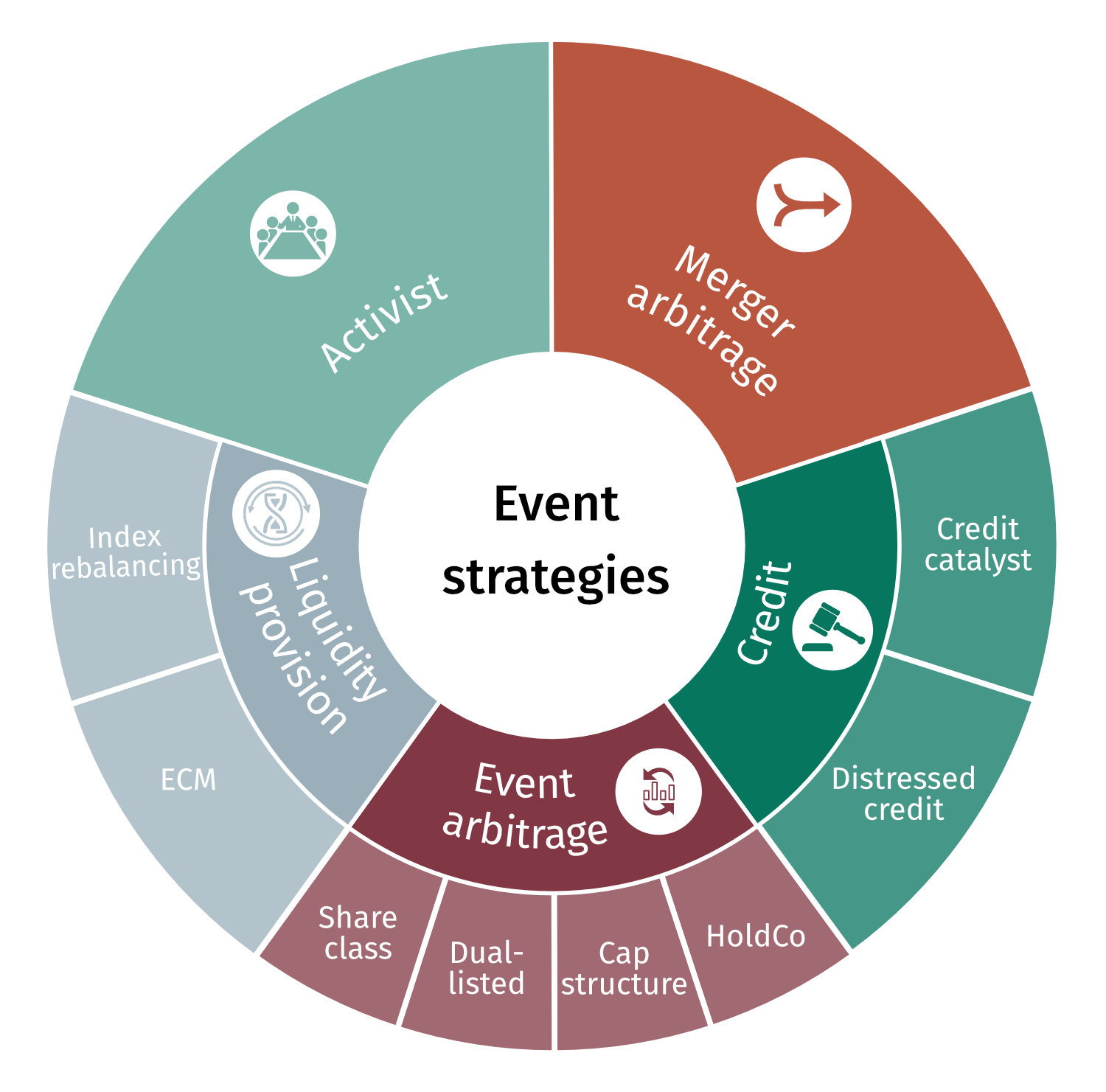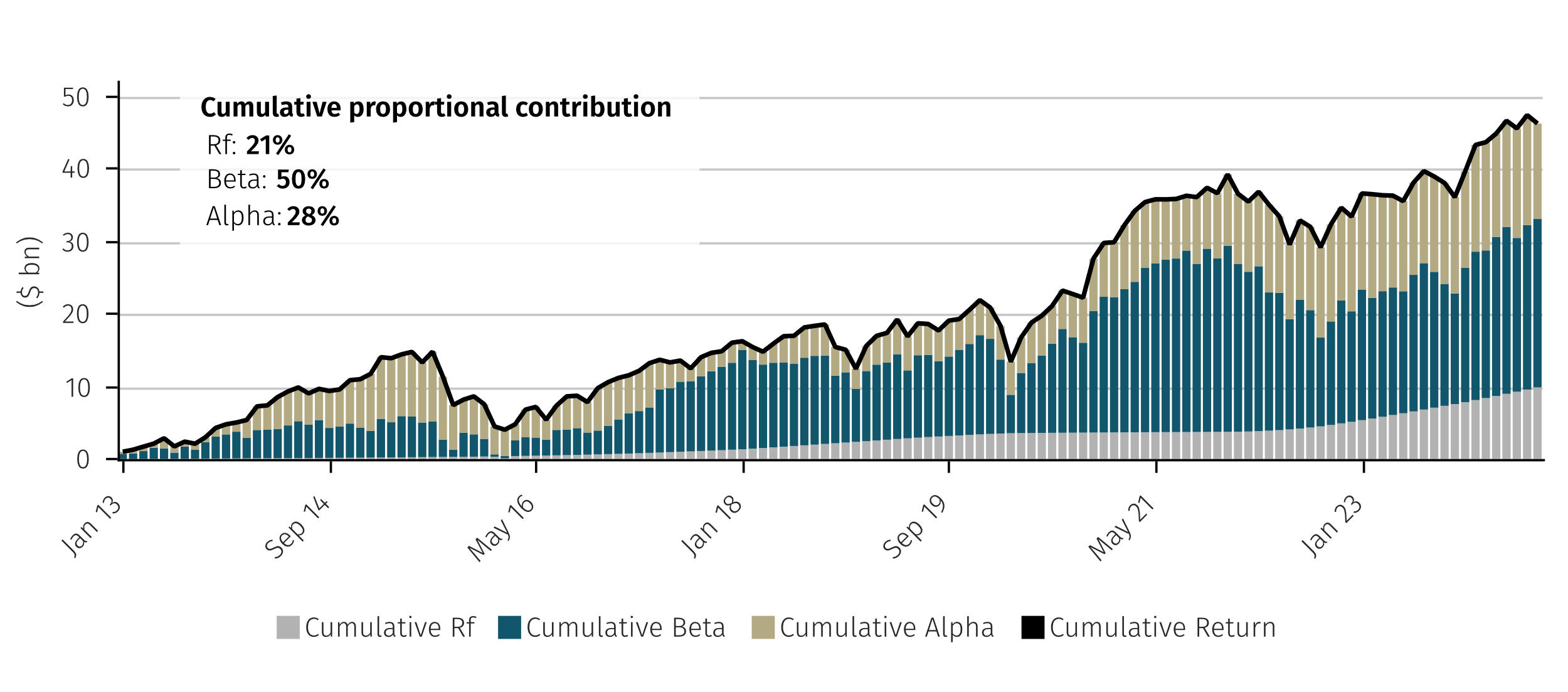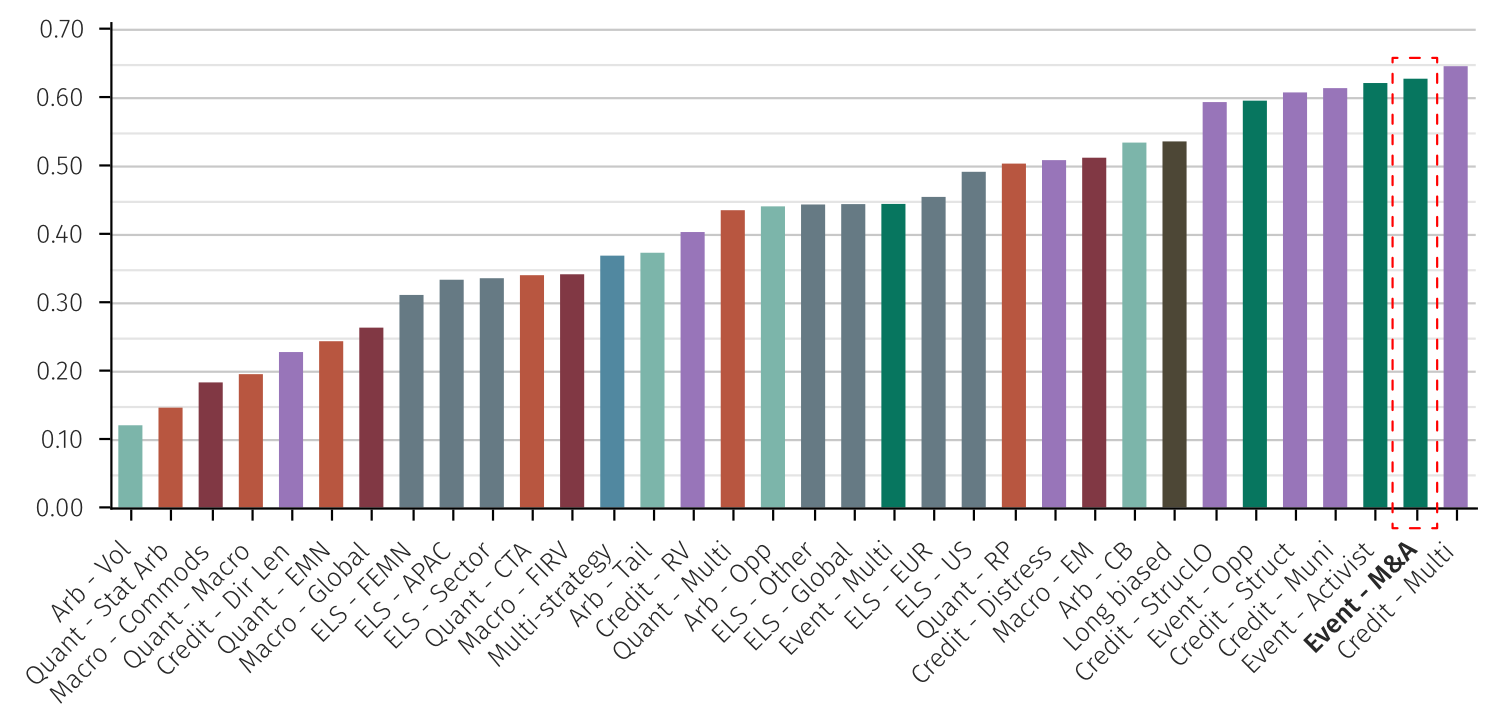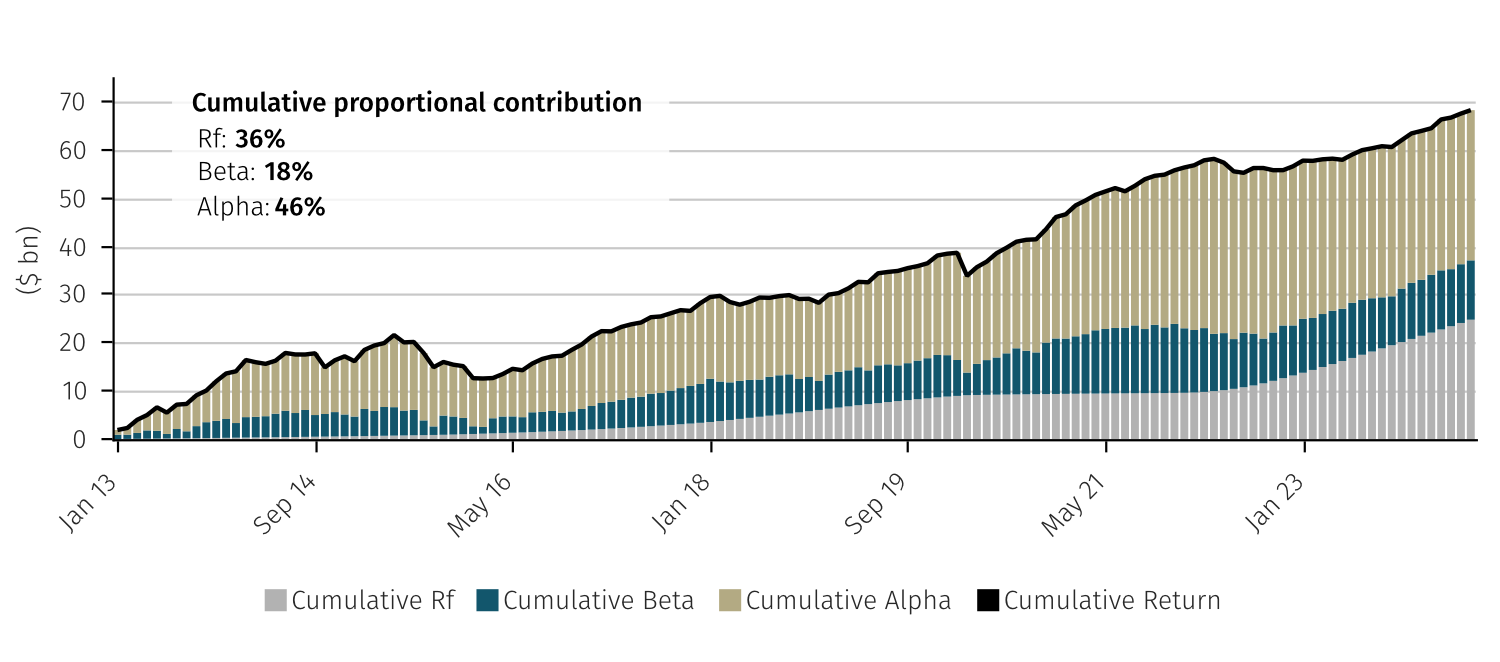Insights
Event hedge fund primer: alpha from corporate catalysts
In summary
Event driven hedge funds focus on exploiting pricing inefficiencies caused by corporate events such as mergers, acquisitions, restructurings, bankruptcies, or other significant corporate actions. The strategy identifies mispriced securities with favourable risk/reward characteristics based upon differentiated views of value-unlocking catalysts, event probabilities and post-event valuations. The success of such strategies is dependent upon the manager’s ability to predict the outcomes of these corporate events accurately and manage the associated risks effectively.
In this article we explore event driven investing, offering insights into the most common event driven strategies. For each strategy, we provide a description, sample trades, and review how each has historically performed in different market environments, considering the unique risk and return profiles associated with these strategies.
The success of event strategies is dependent upon the manager’s ability to predict the outcomes of corporate events accurately and manage the associated risks effectively.
About Aurum
Aurum is an investment management firm focused on selecting hedge funds and managing fund of hedge fund portfolios for some of the world’s most sophisticated investors. Aurum also offers a range of single manager feeder funds.
Aurum’s portfolios are designed to grow and protect clients’ capital, while providing consistent uncorrelated returns. With 30 years of hedge fund investment experience, Aurum’s objective is to lower the barriers to entry enabling investors to access the world’s best hedge funds.
Aurum conducts extensive research and analysis on hedge funds and hedge fund industry trends. This research paper is designed to provide data and insights with the objective of helping investors to better understand hedge funds and their benefits.
What are event driven hedge funds?
Event driven hedge funds deploy investment strategies that capitalise on opportunities arising from specific corporate events. These events include mergers and acquisitions (M&A), spin-offs, restructurings, bankruptcies, and other significant corporate actions. The strategy involves analysing the potential outcomes of these events and their likely impact on the prices of the involved securities, exploiting market inefficiencies and idiosyncratic risks associated with these events.
Event driven managers require a deep understanding of event dynamics, the regulatory environment, and potential market reactions to make informed investment decisions. This often requires specialist knowledge and expertise in areas such as fundamental analysis, legal considerations, credit analysis, market dynamics and corporate strategy. While event driven strategies are primarily expressed via equities, credit instruments such as corporate bonds can also feature in more credit-oriented situations, including bankruptcies, restructurings, and catalyst-driven upgrades or downgrades to credit ratings.
Event driven strategies face specific risks related to the events they target, including delays or failures in event completion due to regulatory hurdles, shareholder opposition, or unexpected changes in corporate strategy. General market conditions and economic factors can also influence the success of event driven strategies, particularly in volatile or uncertain market environments that may impact the feasibility of event completion. Assessing liquidity is crucial, as event driven opportunities can attract many managers, leading to crowded trades. This risk has intensified with the proliferation of event driven sub-strategies within multi-strategy fund structures in recent years.
Most common event-driven strategies
Event driven funds can be categorised in various ways; however, the sub-strategy classifications used in this primer align with those employed by Aurum’s Hedge Fund Data Engine, as follows:
- Activist
- Merger arbitrage
- Event – multi-strategy
- Event – opportunistic
 Activist managers are classified as event driven because they actively seek to create the catalysts that will increase shareholder value. They typically take significant positions in companies to influence management decisions and drive corporate actions, such as restructuring, spin-offs, or changes in corporate governance.
Activist managers are classified as event driven because they actively seek to create the catalysts that will increase shareholder value. They typically take significant positions in companies to influence management decisions and drive corporate actions, such as restructuring, spin-offs, or changes in corporate governance.
Merger arbitrage funds specialise in capitalising on the price differential between the current market price of a target company’s shares and the agreed-upon acquisition price in a merger or acquisition (M&A) deal. This spread reflects the market assessment of the perceived risk and timing of the deal closing, providing arbitrageurs with an opportunity to profit from the completion of the transaction.
Event – multi-strategy and – opportunistic funds are characterised by their diversified approach, investing across multiple event driven sub-strategies. Alongside activism and merger arbitrage, these funds may also allocate to event driven credit and special situations. The latter is a broad category encompassing diverse, less tangible catalyst events, typically focused on companies undergoing significant changes in either corporate or capital structure. Special situations can also include more arbitrage-oriented strategies such as share class arbitrage, dual-listed arbitrage, capital structure arbitrage, and holding company/stub arbitrage. Event – multi-strategy and – opportunistic funds may also deploy liquidity provision strategies, including index rebalancing and equity capital market (ECM) strategies.
While both types of funds can dynamically allocate capital across sub-strategies, the defining characteristic of event – opportunistic funds is their highly flexible and opportunistic approach. These funds may concentrate a significant portion — or even all — of their risk in a specific area based on the prevailing opportunity set. This approach differs from event – multi-strategy funds, which typically remain allocated across multiple sub-strategies at all times, with changes occurring less frequently or dramatically than event – opportunistic funds.
These funds may also allocate a portion of their capital to distressed credit situations, which can also be considered a part of event driven investing. However, if the majority of the fund’s risk or P&L is consistently driven by the strategy, such funds will be classified under Aurum’s credit – distressed credit category. The definition of the sub-strategy can be found here.
Event driven hedge fund strategies represent a relatively modest segment of the hedge fund universe. According to Aurum’s Hedge Fund Data Engine, these strategies account for approximately 10% of the total assets in the hedge fund industry. Nevertheless, event strategies also form a staple component of the larger multi-strategy space, typically comprising between 5-15%+ of the overall allocation.
Risk/return summary
| Activist | Merger arbitrage | Event – multi-strategy | Event – opportunistic | |
|---|---|---|---|---|
| Typical assets traded | Equities | Primarily equities, but may also trade related derivatives and/or credit instruments | Equities and credit, including derivatives thereof | Equities and credit, including derivatives thereof |
| Directional or relative value bias | Directional | Directional or relative value depending on the composition of cash transactions and stock-for-stock transactions | Primarily relative value | Variable |
| Long/short bias | Long-biased | Typically long-biased, depending on the composition of cash transactions and stock-for-stock transactions | Typically no bias | Variable |
| Observed beta to traditional risk assets | High | Low | Low to Medium | Variable |
| Historical volatility relative to other hedge fund strategies | Above average (among the highest) | Below average (among the lowest) | Below average | Variable |
| Liquidity of underlying securities typically traded | High | High | Variable | Variable, dependent on the underlying sub-strategy |
| Typical leverage | Low to medium | Low to medium, but manager dependent | Medium to high | Variable |
Activist
DESCRIPTION

SAMPLE TRADE

PERFORMANCE IN DIFFERENT MARKETS

RISK/RETURN PROFILE

ACTIVIST STRATEGY: DECOMPOSING DOLLAR PERFORMANCE INTO ALPHA, BETA AND RISK FREE (RF) COMPONENTS

Source: Aurum Hedge Fund Data Engine, Bloomberg. These charts decompose the Hedge Fund Composite dollar returns into Beta, Alpha and Risk free (“Rf”) components, as follows: Alpha = Actual return – Rf – Beta * (Market return – Rf).
Where Rf is the Risk-free rate as defined by a rolling 3-month LIBOR-SOFR, where market return is that of S&P Global BMI (‘the market index’) and where Beta has been calculated with respect to each underlying fund observed on a 60m rolling basis to the market index. The monthly Alpha, Beta and Rf components are then applied to each underlying fund’s dollar performance for a particular month, and then at a master strategy or industry level the individual fund dollar contributions are aggregated.
Merger arbitrage
DESCRIPTION

SAMPLE TRADE

PERFORMANCE IN DIFFERENT MARKETS

RISK/RETURN PROFILE

AVERAGE INTRA-STRATEGY CORRELATION (5 YR) – SUB-STRATEGY

Source: Aurum Hedge Fund Data Engine, data to 30 June 2024. 1 Equally weighted returns
Managers can differentiate themselves from their peers in several ways. Some are more willing to actively trade around deals and event milestones, such as regulatory approval announcements, shareholder voting outcomes or other milestones that may impact deal completion. Others focus on more complex or obscure jurisdictions, navigating unique regulatory and market environments to find opportunities overlooked by competitors. Additionally, some managers are willing to short deal positions, a less common practice in merger arbitrage due to the historically high closure rates of announced deals. However, shorting can be an attractive characteristic, offering asymmetry to the upside and providing a hedge against deal failures or broader spread widening.
Event – multi-strategy
DESCRIPTION

STRATEGIES DEPLOYED

EQUITY CAPITAL MARKETS (ECM)

PERFORMANCE IN DIFFERENT MARKETS

RISK/RETURN PROFILE

EVENT – MULTI-STRATEGY: DECOMPOSING DOLLAR PERFORMANCE INTO ALPHA, BETA AND RISK FREE (RF) COMPONENTS

Source: Aurum Hedge Fund Data Engine, Bloomberg. These charts decompose the Hedge Fund Composite dollar returns into Beta, Alpha and Risk free (“Rf”) components, as follows: Alpha = Actual return – Rf – Beta * (Market return – Rf).
Where Rf is the Risk-free rate as defined by a rolling 3-month LIBOR-SOFR, where market return is that of S&P Global BMI (‘the market index’) and where Beta has been calculated with respect to each underlying fund observed on a 60m rolling basis to the market index. The monthly Alpha, Beta and Rf components are then applied to each underlying fund’s dollar performance for a particular month, and then at a master strategy or industry level the individual fund dollar contributions are aggregated.
Event – opportunistic
DESCRIPTION

PERFORMANCE IN DIFFERENT MARKETS

RISK/RETURN PROFILE

For the latest event driven performance and strategy chart packs, click here.
-
Aurum is not and has not been an investor in any funds managed by Elliott Investment Management L.P.
*The Hedge Fund Data Engine is a proprietary database maintained by Aurum Research Limited (“ARL”). For information on index methodology, weighting and composition please refer to https://www.aurum.com/aurum-strategy-engine/. For definitions on how the Strategies and Sub-Strategies are defined please refer to https://www.aurum.com/hedge-fund-strategy-definitions/
Data from the Hedge Fund Data Engine is provided on the following basis: (1) Hedge Fund Data Engine data is provided for informational purposes only; (2) information and data included in the Hedge Fund Data Engine are obtained from various third party sources including Aurum’s own research, regulatory filings, public registers and other data providers and are provided on an “as is” basis; (3) Aurum does not perform any audit or verify the information provided by third parties; (4) Aurum is not responsible for and does not warrant the correctness, accuracy, or reliability of the data in the Hedge Fund Data Engine; (5) any constituents and data points in the Hedge Fund Data Engine may be removed at any time; (6) the completeness of the data may vary in the Hedge Fund Data Engine; (7) Aurum does not warrant that the data in the Hedge Fund Data Engine will be free from any errors, omissions or inaccuracies; (8) the information in the Hedge Fund Data Engine does not constitute an offer or a recommendation to buy or sell any security or financial product or vehicle whatsoever or any type of tax or investment advice or recommendation; (9) past performance is no indication of future results; and (10) Aurum reserves the right to change its Hedge Fund Data Engine methodology at any time and may elect to supress or change underlying data should it be considered optimal for representation and/or accuracy.
Disclaimer
This Post represents the views of the author and their own economic research and analysis. These views do not necessarily reflect the views of Aurum Fund Management Ltd. This Post does not constitute an offer to sell or a solicitation of an offer to buy or an endorsement of any interest in an Aurum Fund or any other fund, or an endorsement for any particular trade, trading strategy or market. This Post is directed at persons having professional experience in matters relating to investments in unregulated collective investment schemes, and should only be used by such persons or investment professionals. Hedge Funds may employ trading methods which risk substantial or complete loss of any amounts invested. The value of your investment and the income you get may go down as well as up. Any performance figures quoted refer to the past and past performance is not a guarantee of future performance or a reliable indicator of future results. Returns may also increase or decrease as a result of currency fluctuations. An investment such as those described in this Post should be regarded as speculative and should not be used as a complete investment programme. This Post is for informational purposes only and not to be relied upon as investment, legal, tax, or financial advice. Whilst the information contained in this Post (including any expression of opinion or forecast) has been obtained from, or is based on, sources believed by Aurum to be reliable, it is not guaranteed as to its accuracy or completeness. This Post is current only at the date it was first published and may no longer be true or complete when viewed by the reader. This Post is provided without obligation on the part of Aurum and its associated companies and on the understanding that any persons who acting upon it or changes their investment position in reliance on it does so entirely at their own risk. In no event will Aurum or any of its associated companies be liable to any person for any direct, indirect, special or consequential damages arising out of any use or reliance on this Post, even if Aurum is expressly advised of the possibility or likelihood of such damages.









